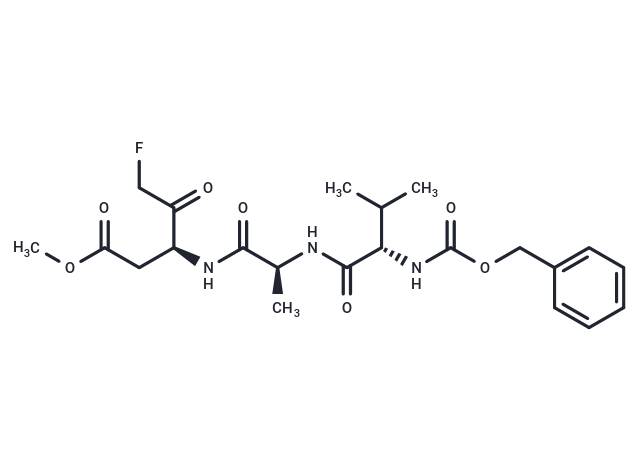Shopping Cart
- Remove All
 Your shopping cart is currently empty
Your shopping cart is currently empty


| Pack Size | Price | Availability | Quantity |
|---|---|---|---|
| 1 mg | $52 | In Stock | |
| 2 mg | $80 | In Stock | |
| 5 mg | $147 | In Stock | |
| 10 mg | $247 | In Stock | |
| 25 mg | $368 | In Stock | |
| 50 mg | $497 | In Stock | |
| 100 mg | $693 | In Stock | |
| 200 mg | $982 | In Stock | |
| 1 mL x 10 mM (in DMSO) | $148 | In Stock |
| Description | Z-VAD(OMe)-FMK is a pan-caspase inhibitor with irreversible properties; Z-VAD(OMe)-FMK is also an inhibitor of ubiquitin C terminal hydrolase L1 (UCHL1), which is irreversibly modified by targeting the UCHL1 active site. |
| In vitro | METHODS: Human leukemia cells HL60 were treated with Z-VAD(OMe)-FMK (50 µM) and camptothecin (50 M) for 3 h. Cell morphology was observed by electron microscopy.
RESULTS: Cells treated with camptothecin exhibited typical apoptotic features including cell shrinkage, chromatin condensation and nuclear fragmentation.Z-VAD(OMe)-FMK combination treatment eliminated the camptothecin-induced apoptotic pattern. Z-VAD(OMe)-FMK alone did not affect cell morphology. [1] METHODS: Cholangiocarcinoma cells KKU100, KKU213A and KKU213B were pretreated with Z-VAD(OMe)-FMK (20 µM) for 1 h, followed by CH-MSCs (0%, 50% and 75%) for 24 h. Apoptosis was detected using Flow Cytometry. RESULTS: Z-VAD(OMe)-FMK pretreatment prevented the apoptosis induced by CH-MSCs. [2] METHODS: Human ovarian teratoma cells PA-1 were treated with Z-VAD(OMe)-FMK (50 μM) and UVB (100 J/m2) for 16 h, and the expression levels of target proteins were detected by Western Blot. RESULTS: Z-VAD(OMe)-FMK eliminated PARP cleavage induced by UVB. [3] |
| In vivo | METHODS: To investigate whether in vivo administration of Z-VAD(OMe)-FMK prevents infection-induced preterm labor, a single intraperitoneal injection of Z-VAD(OMe)-FMK (10 mg/kg) was administered to CD1 mice in which preterm labor was induced by heat-killed group B streptococcus (HK-GBS).
RESULTS: Z-VAD(OMe)-FMK pretreatment delayed but did not prevent HK-GBS-induced preterm labor in a pregnant mouse model. [4] METHODS: To prevent LPS-induced acute lung injury, Z-VAD(OMe)-FMK (0.25 mg 15 min before LPS stimulation, 0.1 mg three times per hour) was injected intravenously into ICR mice with LPS-induced apoptosis and acute lung injury. RESULTS: Z-VAD(OMe)-FMK inhibited caspase-3 activity in lung tissues. Z-VAD(OMe)-FMK significantly prolonged the survival of mice. Apoptosis may play an important role in acute lung injury, and thus inhibition of caspase activity may provide a new therapeutic approach for the treatment of this disease. [5] |
| Cell Research | The human monocytic tumour cell line, THP.1 and the leukaemic T-cell line, Jurkat (clone E-6) were maintained in RPMI 1640 supplemented with 10% (v/v) heat-inactivated fetal calf serum, 100 units/ml penicillin and 100 μg/ml streptomycin in an atmosphere of 5% CO2 in air at 37 °C. The cells were maintained in logarithmic growth phase by routine passage every 2–3 days. To induce apoptosis in THP.1 cells, 2×10^6 cells/ml were incubated either alone or in the presence of cycloheximide (25 μM) and TLCK (100 μM) as previously described. In order to assess the possible effects of various ICE-like protease inhibitors, THP.1 cells were also pretreated for 1 h with Z-VAD.FMK (10 μM), Ac-DEVD-CHO (20 μM) and Ac-YVAD-CHO (20 μM) before being exposed to the apoptotic stimulus. To induce apoptosis in Jurkat cells, 2×10^6 cells/ml were stimulated with 200 ng/ml anti-human Fas as described previously [1]. |
| Animal Research | Mice used in this study were 5- to 6-week-old (20 to 22 g) ICR males. Mice were injected with 30 mg/kg LPS from E. coli serotype O111:B4 through the tail vein. Z-VAD.fmk was dissolved at 2 mg/ml in 1% dimethyl sulfoxide in sterile saline, and administered to mice by the method of Rodriguez et al. A single intravenous injection of Z-VAD.fmk (0.25 mg) was made 15 minutes before LPS injection, followed by three intravenous injections of Z-VAD.fmk (0.1 mg each) per hour. Control mice were injected with the same volume of 1% DMSO in sterile saline [4]. |
| Alias | Z-VAD-FMK, Z-Val-Ala-Asp(OMe)-FMK |
| Molecular Weight | 467.49 |
| Formula | C22H30FN3O7 |
| Cas No. | 187389-52-2 |
| Storage | Powder: -20°C for 3 years | In solvent: -80°C for 1 year | Shipping with blue ice. | ||||||||||||||||||||||||||||||
| Solubility Information | H2O: < 1 mg/mL (insoluble or slightly soluble) Ethanol: < 1 mg/mL (insoluble or slightly soluble) DMSO: 45 mg/mL (96.26 mM) | ||||||||||||||||||||||||||||||
Solution Preparation Table | |||||||||||||||||||||||||||||||
DMSO
| |||||||||||||||||||||||||||||||

Copyright © 2015-2024 TargetMol Chemicals Inc. All Rights Reserved.